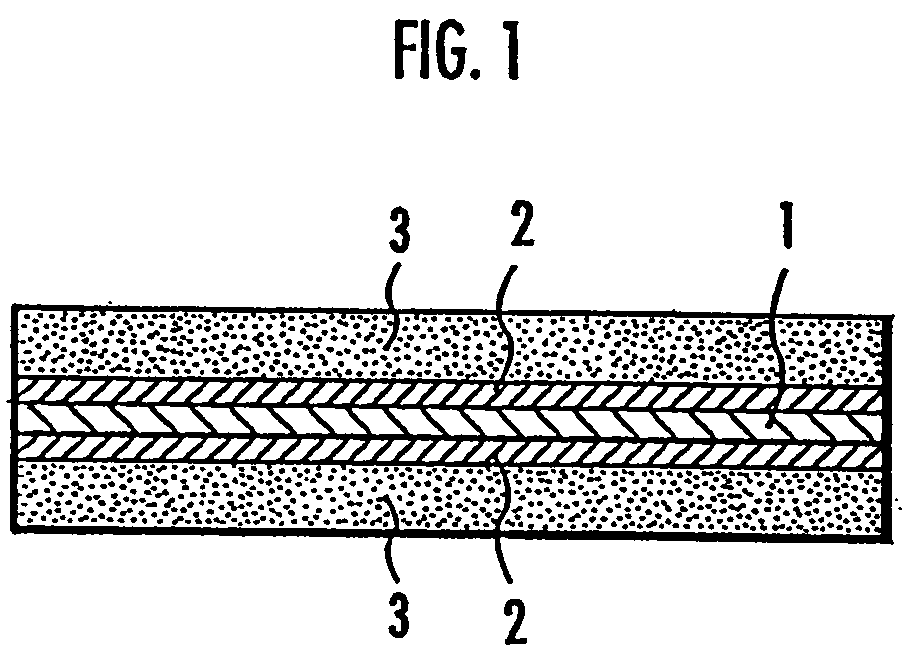Sulfonated Polymer Comprising Nitrile-Type Hydrophobic Block And Solid Polymer Electrolyte
a polymer and hydrophobic block technology, applied in the field of nitrile-containing compounds, can solve the problems of low hot water resistance and oxidation resistance, depletion of oil resources, and increasing global warming, and achieve excellent power generation performance, strong adhesion, and excellent power generation performan
- Summary
- Abstract
- Description
- Claims
- Application Information
AI Technical Summary
Benefits of technology
Problems solved by technology
Method used
Image
Examples
example 1
[0109] In a 1-L three-necked flask equipped with a stirrer, thermometer, Dean-stark trap, nitrogen inlet tube and condenser tube, 48.8 g (284 mmol) of 2,6-dichlorobenzonitrile, 89.5 g (266 mmol) of 2,2-bis(4-hydroxyphenyl)-1,1,1,3,3,3-hexafluoropropane and 47.8 g (346 mmol) of potassium carbonate were weighed. After purging with nitrogen, 346 ml of sulfolane and 173 ml of toluene were added and the resulting mixture was stirred. The reaction mixture was then heated under reflux over an oil bath at 150° C. Water produced by the reaction was taken out of the system by the Dean-stark trap. After the heating under reflux was continued for 3 hours and generation of water was scarcely recognized, toluene was taken out of the system by the Dean-stark trap. The reaction temperature was raised gradually to 200° C., at which stirring was continued for 3 hours. To the reaction mixture was added 9.2 g (53 mmol) of 2,6-dichlrobenzonitrile and the reaction was continued for further 5 hours.
[0110...
example 2
[0134] In a similar manner to Example 1 except that 49.4 g (287 mmol) of 2,6-dichlorobenzonitrile, 88.4 g (263 mmol) of 2,2-bis(4-hydroxyphenyl)-1,1,1,3,3,3-hexafluoropropane and 47.3 g (342 mmol) of potassium carbonate were charged for reaction and the amount of 2,6-dichlorobenzonitrile added in the latter stage of the reaction was changed to 2.3 g (72 mmol), 107 g of the compound represented by the formula (I) was obtained. The number average molecular weight (Mn) by GPC of the compound of the formula (I) obtained in this Example was 7,300.
[0135] Next, in a similar manner to Example 1 except for the use of 134.6 g (336 mmol) of neopentyl 3-(2,5-dichlorobenzoyl)benzenesulfonate, 47.4 g (6.5 mmol) of the oligomer of the formula (1) having Mn of 7,300, 6.71 g (10.3 mmol) of bis(triphenylphosphine)nickel dichloride, 1.54 g (10.3 mmol) of sodium iodide, 35.9 g (137 mmol) of triphenylphosphine and 53.7 g (821 mmol) of zinc, 129 g of a sulfonated polymer represented by the formula (II) ...
example 3
[0138] In a 1-L three-necked 1-L flask equipped with a stirrer, thermometer, Dean-stark trap, nitrogen inlet tube and condenser tube, 44.5 g (259 mmol) of 2,6-dichlorobenzonitrile, 102.0 g (291 mmol) of 9,9-bis(4-hydroxyphenyl)-fluorene and 52.3 g (349 mmol) of potassium carbonate were weighed. After purging with nitrogen, 366 ml of sulfolane and 183 ml of toluene were added and the mixture was stirred. The reaction mixture was then heated under reflux over an oil bath at 150° C. Water produced by the reaction was taken out of the system by the Dean-stark trap. After the heating under reflux was continued for 3 hours and generation of water was scarcely recognized, toluene was taken out of the system by the Dean-stark trap. The reaction temperature was raised gradually to 200° C. and stirring was continued for 3 hours, followed by the addition of 16.7 g (97 mmol) of 2,6-dichlrobenzonitrile. The reaction was continued for further 5 hours.
[0139] After the reaction mixture was allowed...
PUM
| Property | Measurement | Unit |
|---|---|---|
| temperature | aaaaa | aaaaa |
| temperature | aaaaa | aaaaa |
| temperature | aaaaa | aaaaa |
Abstract
Description
Claims
Application Information
 Login to View More
Login to View More - R&D Engineer
- R&D Manager
- IP Professional
- Industry Leading Data Capabilities
- Powerful AI technology
- Patent DNA Extraction
Browse by: Latest US Patents, China's latest patents, Technical Efficacy Thesaurus, Application Domain, Technology Topic, Popular Technical Reports.
© 2024 PatSnap. All rights reserved.Legal|Privacy policy|Modern Slavery Act Transparency Statement|Sitemap|About US| Contact US: help@patsnap.com










